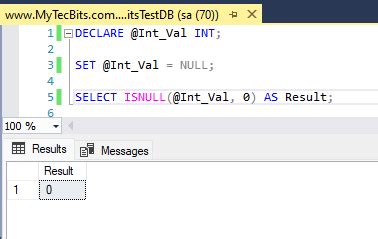When working with databases, it's common to encounter Null values, which represent the absence of any object value. However, in many cases, you may want to replace Null with a default value, such as 0, to facilitate calculations, aggregations, or other operations. This article will guide you through the process of replacing Null with 0 in SQL, providing a comprehensive overview of the methods and techniques involved.
Understanding Null in SQL

Before diving into the replacement techniques, it’s essential to understand how Null values work in SQL. Null is a special value that indicates the absence of any object value. It’s not equal to 0, an empty string, or any other value. When performing arithmetic operations involving Null, the result is usually Null, unless you use a function or operator that handles Null explicitly.
Replacing Null with 0 using the COALESCE Function
One of the most common methods to replace Null with 0 is by using the COALESCE function. This function returns the first non-Null value from a list of arguments. Here’s an example:
SELECT COALESCE(column_name, 0) AS new_column
FROM table_name;
In this example, if the value in `column_name` is Null, the COALESCE function will return 0; otherwise, it will return the original value.
Replacing Null with 0 using the IFNULL Function
Another method to replace Null with 0 is by using the IFNULL function, which is similar to COALESCE but only takes two arguments. Here’s an example:
SELECT IFNULL(column_name, 0) AS new_column
FROM table_name;
This function will return 0 if the value in `column_name` is Null; otherwise, it will return the original value.
Replacing Null with 0 using the ISNULL Function
The ISNULL function is similar to IFNULL and COALESCE, but it’s specific to SQL Server. Here’s an example:
SELECT ISNULL(column_name, 0) AS new_column
FROM table_name;
This function will return 0 if the value in `column_name` is Null; otherwise, it will return the original value.
Replacing Null with 0 using the NVL Function
The NVL function is specific to Oracle and is used to replace Null values. Here’s an example:
SELECT NVL(column_name, 0) AS new_column
FROM table_name;
This function will return 0 if the value in `column_name` is Null; otherwise, it will return the original value.
Comparison of Replacement Methods

Each replacement method has its own advantages and disadvantages. The COALESCE function is generally more flexible, as it can handle multiple arguments, while the IFNULL and ISNULL functions are more concise and easier to read. The NVL function is specific to Oracle and may not be compatible with other databases.
Performance Considerations
When replacing Null values, it’s essential to consider the performance implications. Using functions like COALESCE, IFNULL, or ISNULL can impact query performance, especially when dealing with large datasets. It’s crucial to test and optimize your queries to ensure the best possible performance.
| Replacement Method | Description |
|---|---|
| COALESCE | Returns the first non-Null value from a list of arguments |
| IFNULL | Returns the first non-Null value from two arguments |
| ISNULL | Specific to SQL Server, returns the first non-Null value from two arguments |
| NVL | Specific to Oracle, returns the first non-Null value from two arguments |

Key Points
- Use the COALESCE function to replace Null with 0 in a flexible and concise way
- Use the IFNULL or ISNULL function for a more concise and easier-to-read replacement method
- Use the NVL function in Oracle to replace Null values
- Consider performance implications when replacing Null values
- Use indexes to improve query performance when replacing Null values
Best Practices for Replacing Null Values
When replacing Null values, it’s essential to follow best practices to ensure data integrity and query performance. Here are some guidelines to keep in mind:
- Use the COALESCE function for flexibility and conciseness
- Use the IFNULL or ISNULL function for a more concise and easier-to-read replacement method
- Use the NVL function in Oracle for compatibility
- Consider performance implications when replacing Null values
- Use indexes to improve query performance when replacing Null values
Common Pitfalls to Avoid
When replacing Null values, there are common pitfalls to avoid. Here are some mistakes to watch out for:
- Using the wrong replacement function for your database management system
- Not considering performance implications when replacing Null values
- Not using indexes to improve query performance
- Not testing and optimizing queries to ensure the best possible performance
What is the difference between COALESCE and IFNULL?
+COALESCE returns the first non-Null value from a list of arguments, while IFNULL returns the first non-Null value from two arguments.
How do I improve query performance when replacing Null values?
+Use indexes to improve query performance when replacing Null values. Additionally, test and optimize your queries to ensure the best possible performance.
What is the NVL function used for?
+The NVL function is used to replace Null values in Oracle.
